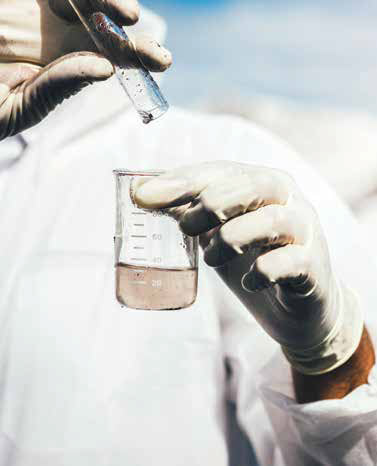Do You Know Where Your Water Has Been?
The long journey from source to tap
Water's hidden journey

Before it gets to our homes, water takes a hidden journey that begins at the source [see infographic: From Source to Faucet]. Water sources include surface water (rivers, lakes, and streams), ground water (aquifers that lie underground), and waste water from our homes that gets treated.
When it rains or snows, the precipitation percolates into aquifers and trickles into bodies of surface water. From these sources, water either gets pumped or flows by gravity into a treatment plant. At the plant, the water is treated via a number of processes specific to the relevant town, state, or federal guidelines. An example process involves water passing through screens to remove debris before being exposed to an agent that causes fine particles to coagulate. The water is transferred into large tanks where those solids sink to the bottom and get removed. The water then passes through sand filters, gets sterilized with chlorine, and is treated with fluoride. After treatment, water is stored in tanks and distributed to our homes through an underground system of pipes, pumps, valves, and storage reservoirs.

In some rural areas, homes may not have connections to municipal water and homeowners rely instead on water extracted directly from the ground into their wells. The layers of rock and sand that the water moves through on its way to the well act as natural filters.
Did you know? Growing a day's food for a family of four requires around 6,800 gallons of water.
Throughout its journey, water has many opportunities to become contaminated. Industrial waste is sometimes dumped into rivers and lakes, or directly into the ground. Pesticides applied to lawns and farmland can enter surface water and groundwater in large quantities. Aging pipes are susceptible to buildup of bacteria. When you flush your toilet, the wastewater ends up in a septic system that discharges effluent to shallow groundwater, which is a common source of contamination. Chemical compounds in prescription drugs can end up in local water supplies if they are flushed or thrown in the garbage. Fats, oils, and grease can produce toxic by-products and accumulate in sewer pipes, hindering wastewater from flowing freely to treatment plants. The list goes on.
Testing the waters

While treatment plants provide a crucial service by removing contaminants from source water, they don’t always do a perfect job. It’s not uncommon to come across news reports about communities being subjected to unhealthy levels of contaminants in their drinking water.
It is therefore important that treated water be rigorously tested before it is deemed safe to use. Water samples must be collected from treatment plants, storage facilities, distribution networks, and points of use, stored under proper conditions, and transported to a lab.
Did you know? Over 90 percent of the world's supply of fresh water is located in Antarctica.

Once in the lab, the sample preparation step serves to separate contaminants from the water matrix. Those contaminants are then quantified using analytical methods such as chromatography and mass spectrometry. Finally, the resulting data must be validated and properly reported.
A modern technique that is utilized for separating analytes from aqueous matrices is solid phase extraction (SPE). Compared to liquid-liquid extraction, SPE uses less solvent, generates less waste, reduces the operator’s exposure to harsh solvents and solvent vapors, and eliminates the chance for forming emulsions.
Effective solid phase extraction requires the right system

To measure the concentration of oil and grease in water, n-hexane is often used to extract oils, greases, and other hexane-extractable materials from samples. Horizon Technology’s SPE-DEX® 3100 offers several useful features for extraction of hexane-extractable analytes from water:
- A dedicated controller with pre-loaded methods streamlines method development
- The compact footprint saves valuable bench space
- Flexible to accommodate 47 mm and 90 mm SPE disks
- Highly efficient extractions reduce solvent usage and generate less hazardous waste
- Built-in sensors and safety mechanisms enable worryfree, unattended operation
Solid phase extraction is also used routinely in a variety of applications where volatile and semi-volatile compounds must be quantified in aqueous sample matrices. When preparing these samples for analysis, Horizon Technology’s SPE-DEX® 5000 offers the following features:
- Intuitive software streamlines method development
- Rugged hardware to tackle samples with varying levels of particulates
- Accurate solvent delivery results in superior analyte recovery and reproducibility
- Minimal maintenance reduces downtime and overhead costs
- Automated, unattended operation maximizes throughput and productivity
Download the free Infographic at www.labmanager.com/source-to-faucet
Horizon Technology, Inc. offers expertise in instruments, applications, consumables, and technical support for solid phase extraction, solvent drying, and concentration.
